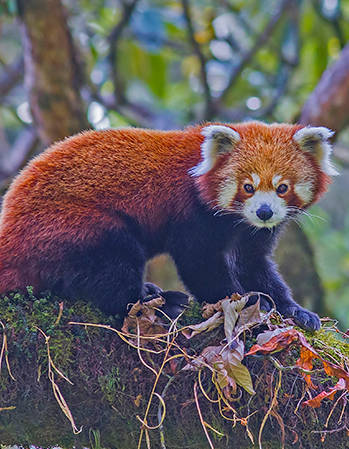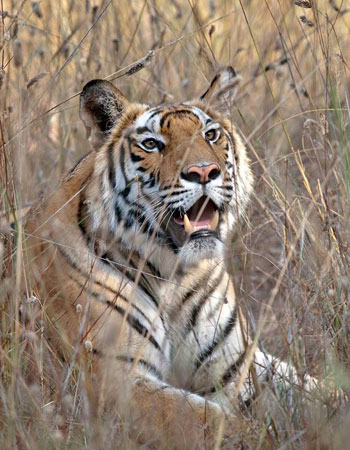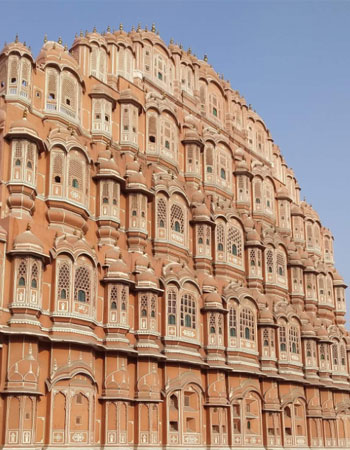Kanha National Park
How to Get there?
![]() Located 04 hours away
from Raipur Airport – accessible by flights from New Delhi, Mumbai and Bangalore.
Located 04 hours away
from Raipur Airport – accessible by flights from New Delhi, Mumbai and Bangalore.
Type of Safari at the Park?
![]() Half-Day Jeep
Safari
Half-Day Jeep
Safari
![]() Full-Day Jeep
Safari i
Full-Day Jeep
Safari i
![]() Walking Trails in
the Buffer Area
Walking Trails in
the Buffer Area
History & Overview
A A Dunbar Brander (1923) in his book Wild Animals in Central India say, “ In 1900 this tract contained as much game as any tract I ever saw in the best parts of Africa in 1908. I have seen 1500 heads consisting of 11 species in an evening’s stroll”. It is nothing like that now, but it is probably true to say that Kanha still contains more numbers and more species than any other tract of its size in the whole of Asia. Similar feelings were echoed by George Schaller when he did his study in the 60s decade in various parks of India. He mentioned that Kanha is the finest reserve in India.
Kanha is located in the southernmost part of Madhya Pradesh. The altitude of the park ranges from 1700 feet to 2900 feet. The central part of Kanha is in shape of amphitheater about 9 kms in diameter, and surrounded by hills on three sides, and many valleys and ridges beyond them.
One associates Central India with being a water-stricken and rather hot area – however the opposite holds true for Kanha. It is flanked by Banjar and Halon river on two sides, with some perennial streams from the Chilled winters, availability of water around the year and coolness in the early morning and evening in peak summer characterise the uniqueness of this place.
Being in the tribal belt of South-eastern Madhya Pradesh, the Baigas are the aboriginals of the area. They practiced shifting cultivation until it was banned in 1868. Kanha has retained its rich old forest tracts which forms corridors for animals, especially migrating tigers, to other forests in Madhya Pradesh such as Pench as well as Achanakmar in Chattisgarh. Without these corridors, the medium to long-term survival of tigers hangs in the balance.
Kanha Tiger Reserve is spread over 2200 sq.km and maintains a core area of 940 sq.km – it has between 80 to 100 tigers in the wild. Kanha National Park is a combination of dry deciduous and moist deciduous forest dominated by old and towering Sal trees and its famous meadows where the critically endangered Hard Ground Swamp Deer or “Barasingha” has its last stronghold.
These large deer have their rutting or mating season in winter and their magnificent winter coats and the beautifully decorated “Bara singh” or twelve-tined antlers are a treat to behold.During a tiger safari in Kanha National Park one can hope to see large yet elusive tigers walking on the jeep tracks as they traverse through the comparatively more comfortable road to announce their presence.
Birding is fantastic here, with species such as the Greater Racquet-tailed Drongo, Scarlet Minivet, Crested Hawk Eagle, Emerald Dove and Rufous Woodpecker catching the eye amongst 350+species recorded here.
Flora and Fauna
| Wildlife | Birds |
| Royal Bengal Tiger | Indian Golden Oriole |
| Chital | Malabar Pied Hornbill |
| Sambhar | Alexandrine Parakeet |
| Hard Ground barasingha | Crested Serpent Eagle |
| Chousingha | Green Bee Eater |
| Sloth Bear | Tickle’s blue Fly Catcher |
| Gaur | Brahminy Starling |
| Mouse Deer | Yellow Footed Green Pigeon |
| Barking deer | White Rumped Shama |
| Wild Boar | Emerald Dove |
Geography and Climate
| Area | 2051 sq. km- 940 sq. km is core and 1134 sq. km is buffer forest. |
| Co-ordinates | Latitude: 22° 7′ to 22° 27’N; longitude: 80° 26′ to 81° 3’E. |
| Weekly Off | Wednesday Afternoon Safari |
| Yearly Off | Holi, Diwali |
| Functional Days | 01st Oct - 30th June |
| Rainfall | 1443mm |
| Forest Type | Moist deciduous forest (predominantly a Sal forest) |
Enquire Tour
Tours
National Parks
Explore

Post - Tala, Bandhavgarh National Park, District - Umaria, Madhya Pradesh, Pin code - 484664
+91 9630507774, +91 9340711175Email : info@tigerjourney.in
© 2020 All Rights Reserved






